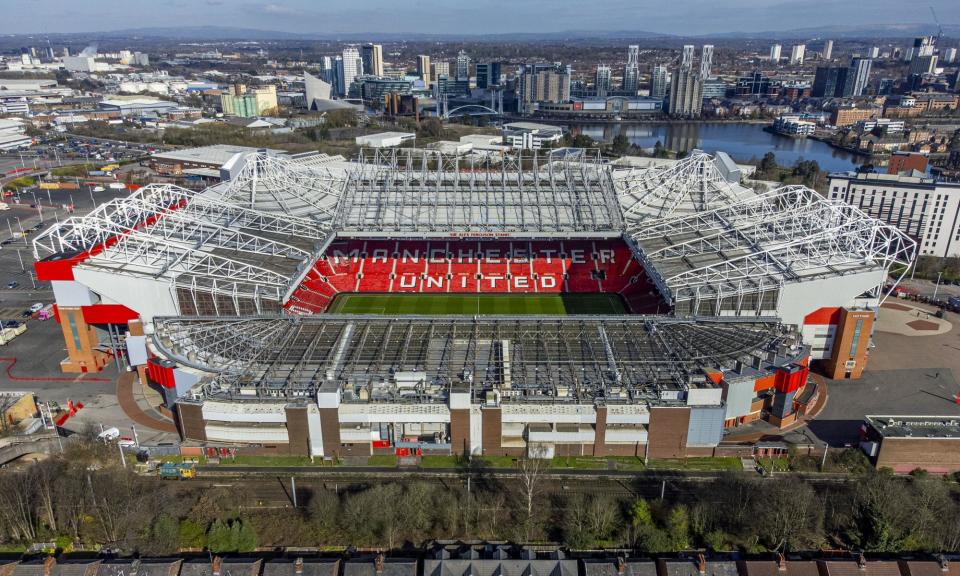Manchester United and the future of Old Trafford: key questions answered

Isn’t Old Trafford good enough as it is?
No. Old Trafford is 114 years old and tired with no notable modernisation since Malcolm Glazer bought the club in 2005. Sir Jim Ratcliffe, the incoming 25% owner, wishes to address this. One option is to build a new stadium on the land that surrounds the current one which, according to Ineos sources, could be billed as “the Wembley of the North”.
Related: Patience and support: how Højlund found his feet at Manchester United
How would that work?
The idea would be to construct a bespoke state-of-the-art facility with a capacity of about 100,000 that would cost more than £3bn. Alongside this glittering new jewel in the club crown could be boutiques, restaurants, fast-food eateries, a multiscreen cinema, a club museum and copious other attractions that would make this a destination venue. Think the £2bn Tottenham Hotspur Stadium but even grander to ensure bragging rights befitting England’s record 20-times champions and Ratcliffe’s sense of ambition as United’s moderniser. Thus “the Wembley of the North” soundbite.
‘Wembley of the North’: really?
Erm, kind of. Yes, because Old Trafford’s failure to be a venue for Euro 2028 points to its decrepit, fading condition as a relic from the 1990s so a reset is required. No, because, actually, it can already be billed as the de facto Wembley of the region. Why: because despite being decrepit, the 75,000-seat ground has a storied history dating from 1910 graced by Billy Meredith, George Best, the Sirs Matt Busby and Alex Ferguson, Eric Cantona, Cristiano Ronaldo, plus copious others. And it is comfortably England’s biggest football stadium besides Wembley.
Could government money go towards this?
Probably a no on this, certainly with regard to a sizeable chunk of the finance required. United could lobby the government for finance as part of its levelling up project and although there may be a few million pounds – possibly in tax breaks – for the project, the Guardian has been told by those with knowledge of the plans that because this is a private business initiative the money, in the main, will have to be sourced from this sector too.
How likely is the building of a new stadium there?
Call it 60-40 in favour. Ratcliffe’s arrival nudges up the likelihood because he has (so far) demonstrated he means business, embodied by the hiring of Omar Berrada from Manchester City to be the new chief executive. But there should be caution because even with the $300m he is injecting into the club later this year that raises Ratlciffe’s holding to 28%, the six Glazer siblings remain majority owners and their track record regarding Old Trafford is unimpressive. When Ratcliffe’s deal was announced on Christmas Eve it was said he would “provide an additional $300m intended to enable future investment into Old Trafford” but it could also be used for other purposes.
How long would the project take?
Six to eight years.
Where would United play during construction?
Good question. United sources have previously indicated it may not be possible to play at Old Trafford while a new stadium was being built. Across town there is a 53,000-seat stadium (soon to be 60,000) but could United really play at City’s Etihad Stadium? One answer is that once fans of each team became used to it, why not? The Milan clubs, for example, share San Siro, and United used City’s former ground, Maine Road, when Old Trafford was bombed during the second world war and in the 1950s for three European games because their stadium lacked floodlights. If the Etihad is a no-no then this presumably rules out Anfield for the same reason (Liverpool are even fiercer rivals) so maybe the new Everton stadium? Or, how about the Wembley of the South: Wembley. After all, according to the tired joke, the vast constituency of United’s fanbase are Londoners.
What would happen to Old Trafford?
It may be downsized to become the women’s and academy stadium. Or somehow reconfigured to be the site of the museum.
Any alternatives?
Yes. A revamp of Old Trafford. However, the train track adjacent to it means limitations.

 Yahoo Sport
Yahoo Sport 



































































